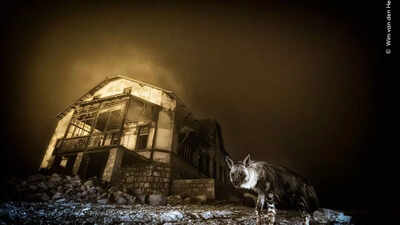ARTICLE AD BOX

In the quiet, abandoned streets of Kolmanskop, a former diamond-mining ghost town in Namibia, a rare brown hyena roams under the cover of night. South African photographer Wim van den Heever captured this elusive creature in a haunting image titled Ghost Town Visitor, which has since won the prestigious Wildlife Photographer of the Year 2025 award.
The photograph also secured the Urban Wildlife category and is the result of a decade-long pursuit using camera trap technology. Van den Heever’s meticulous planning and patience allowed him to document the nocturnal hyena in an abandoned human space, revealing a world where wildlife quietly reclaims territory left behind by humans.Van den Heever’s photograph beat out over 60,000 submissions from 113 countries, cementing its status as a standout entry.
The photograph is more than a striking visual; it tells a story of resilience, adaptation, and coexistence. Brown hyenas are among the rarest hyena species in the world, largely solitary and nocturnal, making them exceptionally difficult to photograph. By carefully monitoring their tracks and behaviour, van den Heever transformed the eerie silence of Kolmanskop into a stage for a wildlife masterpiece.
Reflecting on the moment he finally captured the shot, van den Heever said, “Can I say I was doing cartwheels? I was extremely, extremely happy, I couldn’t believe it.”
The journey to capturing the perfect shot
Nocturnal and solitary, brown hyenas are notoriously difficult to spot. After noticing paw prints and scat in Kolmanskop, van den Heever realised that photographing them in person would be nearly impossible. He turned to camera traps, setting up equipment in strategic locations and waiting patiently for the right moment. Over ten years, he faced challenges ranging from shifting light conditions and false triggers to huge dumps of sand blown in from the desert.
Each setback required recalibration, testing both his technical skill and patience.When the moment finally arrived, van den Heever captured a ghostly, almost cinematic portrait of the hyena beside a decaying building, with fog drifting in from the Atlantic Ocean. The image is a haunting yet mesmerising juxtaposition of nature reclaiming abandoned human spaces in a deserted diamond mining town, highlighting the unique setting that makes this photograph exceptional.
The story behind Ghost Town Visitor
The photograph is not only visually compelling but symbolically powerful. Akanksha Sood Singh, a judge of the competition, described it as “a multi-layered story of loss, resilience, and the natural world’s silent triumph.” The image conveys the quiet reclamation of urban spaces by wildlife, reminding viewers that nature often persists and adapts even in areas abandoned by humans.

At the same time, the photo reflects a growing concern: as urban areas expand and natural habitats shrink, wild animals are increasingly forced into human-dominated landscapes.
Many species are losing their homes and are seen venturing into towns and cities, a silent plea for survival and space. The haunting presence of the hyena in Kolmanskop serves as a stark reminder of the fragile balance between human development and wildlife conservation.
Other notable winners and categories
Alongside van den Heever, several other photographers were recognised for their compelling work:Impact Award: Brazilian photographer Fernando Faciole won for Orphan of the Road, capturing a giant anteater pup following its human caregiver after being orphaned in a road accident.

Young Wildlife Photographer of the Year: Italian Andrea Dominizi, aged 17, captured a longhorn beetle surveying abandoned logging machinery in the Lepini Mountains of Italy.

Rising Star Award: German photographer Luca Lorenz photographed a coypu playfully interacting with mute swans in an urban lake.Photojournalism Story Award: Spaniard Javier Aznar González de Rueda documented the complex relationship between humans and rattlesnakes across the United States.Portfolio Award: Alexey Kharitonov, a self-taught photographer, documented remote terrains of Siberia and the Russian North with drone photography.
Conservation messages through photography
Many of the winning images highlighted pressing conservation issues. From orphaned wildlife to endangered species and habitat loss, the photographs offered insights into the resilience of animals in human-altered landscapes. The Natural History Museum of London, where the exhibition will be held, has paired this year’s award-winning photos with its Biodiversity Intactness Index, allowing visitors to understand how species populations and habitats are changing globally.By juxtaposing art and science, the competition underscores the importance of visual storytelling in inspiring awareness and action on the fragility and beauty of the natural world.
Why Ghost Town Visitor stands out
Ghost Town Visitor is more than a photograph—it is a narrative of perseverance, patient observation, and ecological storytelling. It reminds viewers of the delicate balance between human spaces and wildlife, while celebrating the extraordinary adaptability of animals. The ghostly hyena prowling through a deserted diamond-mining ghost town adds an eerie yet poetic context, enhancing the story of nature reclaiming abandoned spaces.
With its ethereal quality, the image captures imagination and raises awareness about the hidden lives of urban wildlife, leaving a lasting impression on audiences worldwide.

 11 hours ago
2
11 hours ago
2









 English (US) ·
English (US) ·